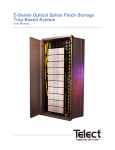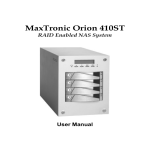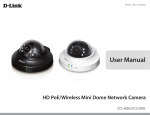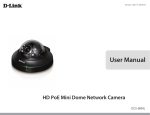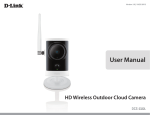Download D-Link DCS 6210 User manual
Transcript
Version 1.1 | 11/08/2012 User Manual Full HD Mini Fixed Dome Network Camera DCS-6210 Preface D-Link reserves the right to revise this publication and to make changes in the content hereof without obligation to notify any person or organization of such revisions or changes. Information in this document may become obsolete as our services and websites develop and change. Please refer to the www.mydlink.com website for the most current information. Manual Revisions Revision Date 1.0 October 11, 2012 1.1 November 08, 2012 Description DCS-6210 Revision A1 with firmware version 1.00 DCS-6210 Revision A1 with power consumption revise Trademarks D-Link and the D-Link logo are trademarks or registered trademarks of D-Link Corporation or its subsidiaries in the United States or other countries. All other company or product names mentioned herein are trademarks or registered trademarks of their respective companies. Copyright © 2012 D-Link Corporation. All rights reserved. This publication may not be reproduced, in whole or in part, without prior expressed written permission from D-Link Corporation. D-Link DCS-6210 User Manual 2 Table of Contents Product Overview......................................................... 4 Audio and Video...............................................................37 Package Contents.................................................................. 4 Preset....................................................................................39 Introduction............................................................................. 5 Motion Detection............................................................41 System Requirements.......................................................... 5 Time and Date...................................................................42 Features..................................................................................... 6 Event Setup........................................................................43 Hardware Overview.............................................................. 7 SD Card................................................................................51 Outside.................................................................................. 7 HTTPS...................................................................................52 Internal.................................................................................. 8 Access List...........................................................................53 Installing or Removing an SD Card................................. 9 Maintenance..........................................................................54 Camera Installation Wizard..............................................10 Device Management......................................................54 Manual Hardware Installation.........................................17 System.................................................................................55 Adjusting the Camera........................................................19 Firmware Upgrade...........................................................56 Mounting the Camera........................................................20 Status.......................................................................................57 Configuration.............................................................22 Device Info.........................................................................57 Using the Configuration Interface.................................22 Logs......................................................................................58 Live Video...............................................................................23 Help......................................................................................59 Setup........................................................................................25 Technical Specifications.............................................60 Setup Wizard.....................................................................25 Safety Statements......................................................62 Network Setup..................................................................31 Dynamic DNS....................................................................34 Image Setup......................................................................35 D-Link DCS-6210 User Manual 3 Section 1: Product Overview Product Overview Package Contents DCS‑6210 Full HD Mini Fixed Dome Network Camera CAT5 Ethernet cable Power adapter CD-ROM with User Manual and software Quick Installation Guide Alignment Sticker Screwdriver and screws for installation Weatherproofing rubber screw coverings If any of the above items are missing, please contact your reseller. Note: Using a power supply with a different voltage than the one included with your product will cause damage and void the warranty for this product. D-Link DCS-6210 User Manual 4 Section 1: Product Overview Introduction Congratulations on your purchase of the DCS-6210 Full HD Mini Fixed Dome Network Camera. The DCS-6210 is a versatile and unique solution for your small office or home. Unlike a standard webcam, the DCS-6210 is a complete system with a built-in CPU and web server that transmits high quality video images for security and outdoor surveillance. The DCS-6210 can be accessed remotely, and controlled from any PC/Notebook over your local network or through the Internet via a web browser. The simple installation and intuitive web-based interface offer easy integration with your Ethernet/Fast Ethernet network. The DCS-6210 vandal-proof housing and Power over Ethernet make it an ideal solution for a complete and cost-effective surveillance solution with an easy clutter-free installation. The remote monitoring, infrared, motion detection and event notifications features enable you be truly responsive to your surveillance deployment. System Requirements • • • • • • Computer with Microsoft Windows® 7, Vista®, or XP (for CD-ROM Setup Wizard), Mac OS or Linux PC with 1.3GHz or above; at least 128MB RAM Internet Explorer 7 or above , Firefox 3.5 or above, Safari 4 and Chrome 8.0 or above Existing 10/100 Ethernet-based network or 802.11n wireless network A MicroSD memory card (optional) is required for recording to onboard storage. SDHC Class 6 or above is recommended. Broadband Internet connection D-Link DCS-6210 User Manual 5 Section 1: Product Overview Features Simple to Use The DCS-6210 is a stand-alone system with a built-in CPU, requiring no special hardware or software. The DCS-6210 supports both ActiveX mode for Internet Explorer and Java mode for other browsers such as Firefox® and Safari®. Supports a Variety of Platforms Supporting TCP/IP networking, HTTP, and other Internet related protocols. The DCS-6210 can also be integrated easily into other Internet/Intranet applications because of its standards-based features. The DCS-6210 offers Ethernet/Fast Ethernet connectivity, making the DCS-6210 easy to integrate into your existing network environment. The DCS-6210 works with a 10Mbps Ethernet based network or 100Mbps Fast Ethernet based network for traditional wired environments. Web Configuration Using a standard Web browser, administrators can configure and manage the Network Camera directly from its own Web page via Intranet or Internet. This means you can access your DCS-6210 anytime, anywhere in the world. IK10 Vandal-proof & IP66 Weather-proof Housing The DCS-6210 uses IK10 vandal-proof and IP66 weatherproof housing, allowing you to rest assured that in the toughest of conditions, it will continue to provide round-the-clock surveillance at vandal-prone locations such as transportation hubs, schools, or correctional facilities both in all weathers. Broad Range of Applications With today’s high-speed Internet services, the Network Camera can provide the ideal solution for delivering live video images over the Intranet and Internet for remote monitoring. The Network Camera allows remote access using a Web browser for live image viewing, and allows the administrator to manage and control the Network Camera anytime, anywhere in the world. Many applications exist, including industrial and public monitoring of homes, offices, banks, hospitals, child-care centers, and amusement parks. Remote Monitoring Utility The D-ViewCam application adds enhanced features and functionality for the Network Camera and allows administrators to configure and access the Network Camera from a remote site via Intranet or Internet. Other features include image monitoring, recording images to a hard drive, viewing up to 32 cameras on one screen, and taking snapshots. PoE (Power over Ethernet) for Flexible Installation The DCS-6210 can draw all the power it needs from a powered Ethernet port meaning installation is simple and clutter free. D-Link DCS-6210 User Manual 6 Section 1: Product Overview Hardware Overview Outside 5 1 6 2 7 3 4 1 Cable Harness The cable harness retains the individual cables for easier manipulation 2 Ethernet Port Connects to an RJ45 Ethernet cable or PoE cable to connect to your network 3 Reset Button Press and hold the recessed button for 10 seconds to reset the camera 4 Power Connector 5 Microphone Built in microphone records audio of the surrounding area 6 Camera Lens Full HD Fixed Lens records video of the surrounding area 7 Camera Cover Remove the cover to adjust the Camera Lens and access the Micro SD Card slot D-Link DCS-6210 User Manual Power receptor for the provided power adapter 7 Section 1: Product Overview Internal 4 1 2 3 4 You can access the inside of the DCS-6210 by loosening the 3 security screws, then lifting the cover off of the camera. 1 LED 2 SD/SDHC Card Slot 3 Adjustable Lens Seat Adjustable triple ring lens mount. 4 Mounting Screw Hole Guide to assist correct casing alignment with the cable channel. D-Link DCS-6210 User Manual Power and network indicator. Insert an SD/SDHC card for storing internal recorded images and video. 8 Section 1: Product Overview Installing or Removing an SD Card 2 3 Step 1: Place the camera face down on a non-slip flat surface. Step 2: Open the camera enclosure by loosening the 3 screws. Lift the dome off the base of the camera. Step 3: Push the SD card into the camera with the gold contacts oriented towards the base of the camera. To eject the SD card, push the SD card into the slot. Step 4: Replace the dome enclosure ensuring a tight fit. Note: To ensure that the camera stays weatherproof, users are advised to ensure that the weatherproof sheath is secured firmly in place. D-Link DCS-6210 User Manual 9 Section 2: Installation Camera Installation Wizard Insert the DCS-6210 CD into your computer's CD-ROM drive to begin the installation. If the Autorun function on your computer is disabled, or if the D-Link Launcher fails to start automatically, click Start > Run. Type D:\autorun.exe, where D: represents the drive letter of your CD-ROM drive. The CD-ROM will open the Camera Installation Wizard. Simply click Setup Wizard to go through the Installation Wizard, which will guide you through the installation process from connecting your hardware to configuring your camera. D-Link DCS-6210 User Manual 10 Section 2: Installation After clicking Setup Wizard, the following window will open. Click Next to continue. Click Yes to accept the License Agreement. D-Link DCS-6210 User Manual 11 Section 2: Installation To start the installation process, click Next. Note: The installation may take several minutes to finish. Click Finish to complete the installation. D-Link DCS-6210 User Manual 12 Section 2: Installation Click on the D-Link Setup Wizard SE icon that was created in your Windows Start menu. Start > D-Link > Setup Wizard SE The Setup Wizard will appear and display the MAC address and IP address of your camera(s). If you have a DHCP server on your network, a valid IP Address will be displayed. If your network does not use a DHCP server, the network camera's default static IP 192.168.0.20 will be displayed. Click the Wizard button to continue. D-Link DCS-6210 User Manual 13 Section 2: Installation Enter the Admin ID and password. When logging in for the first time, the default Admin ID is admin with the password left blank. Click Next, to proceed to the next page. Select DHCP if your camera obtains an IP address automatically when it boots up. Select static IP if the camera will use the same IP address each time it is started. Click Next, to proceed to the next page. D-Link DCS-6210 User Manual 14 Section 2: Installation Take a moment to confirm your settings and click Restart. Click on the D-Link Setup Wizard SE icon that was created in your Windows Start menu. Start > D-Link > Setup Wizard SE Select the camera and click the button labeled "Link" to access the web configuration. The Setup Wizard will automatically open your web browser to the IP address of the camera. D-Link DCS-6210 User Manual 15 Section 2: Installation Enter admin as the default username and leave the password blank. Click OK to continue. This section shows your camera’s live video. You can select your video profile and view or operate the camera. For additional information about web configuration"Configuration" on page 22. D-Link DCS-6210 User Manual 16 Section 2: Installation Manual Hardware Installation If you wish to set up your camera without using the Camera Setup Wizard, please follow these steps. General connection with 12 V DC Power Adaptor Step 1 Place the camera on a non-slip surface. Using the provided Ethernet cable connect the provided Ethernet cable to the Ethernet port on the Cable harness Step 2 Connect the other end of the Ethernet cable your network.. 1 2 D-Link DCS-6210 User Manual 17 Section 2: Installation Connection using PoE Step 1 If you are using a PoE hub, connect the IP camera to the hub via an Ethernet cable, which will provide transmission of both power and data over a single cable. Step 2 Connect the other end of the Ethernet cable your network.. 1 2 D-Link DCS-6210 User Manual 18 Section 2: Installation Adjusting the Camera The DCS-6210 can be focused by adjusting the lens. Step 1 Place the camera on a non-slip surface. 3 Step 2 Remove the cover by following the steps outlined in "Installing or Removing an SD Card" on page 9. Step 3 Adjust the Viewing Angle of the 3-axis Mechanism by turning the lens module left and right until the desired position is achieved. Step 4 Turn the lens up and down until the desired position is achieved. 4 Step 5 Turn the lens to adjust the IP camera’s image until the desired orientation is achieved Step 6 Seat the cover and fasten the three security screws. Step 7 Insert the weatherproof rubber screw coverings over the screws ensuring a tight seal. D-Link DCS-6210 User Manual 5 19 Section 2: Installation Mounting the Camera The DCS-6210 is suitable for mounting to a ceiling or wall. Step 1 Position the alignment sticker in the desired location for the camera. Step 2 Use a 6mm drill bit to make required holes approximately 25mm deep. Step 3 Insert wall anchors. 1 3 Step 4 Affix the DCS-6210 base using the screws provided. Step 5 Adjust the Lens. For detailed instructions on adjusting the lens see "Adjusting the Camera" on page 19 4 5 D-Link DCS-6210 User Manual 20 Section 2: Installation Step 6 Affix the DCS-6210 dome using the screws provided. Step 7 Insert the weatherproof rubber screw coverings over the screws ensuring a tight seal. 6 Note: When mounting ensure the camera is oriented with the cables positioned to the bottom of the device. D-Link DCS-6210 User Manual 21 Section 4: Configuration Configuration Using the Configuration Interface After completing the Camera Installation Wizard, you are ready to use your camera. The camera’s built-in Web configuration utility is designed to allow you to easily access and configure your DCS-6210. At the end of the wizard, click Go To Camera, or enter the IP address of your camera into a web browser, such as Mozilla Firefox. To log in, use the User name admin and the password you created in the Installation Wizard. If you did not create a password, the default password is blank. After entering your password, click OK. D-Link DCS-6210 User Manual 22 Section 4: Configuration Live Video This section shows your camera’s live video. You may select any of the available icons listed below to operate the camera. You may also select your language using the drop-down menu on the left side of the screen. You can zoom in and out on the live video image using your mouse. Right-click to zoom out or left-click to zoom in on the image. SD Status: This option displays the status of the SD card. If no SD card has been inserted, this screen will display the message "Card Invalid." Motion Trigger Indicator This indicator will change color when a trigger event occurs. Stop Note: The video motion feature for your camera must be enabled. When a recording is in progress, this indicator will change color. This control pad can be used to electronically pan, tilt, and zoom (ePTZ) within the camera's predefined view area, if one has been defined. Starts the automatic panning function. The ROI will pan from back and forth within the FOV Stops the camera ePTZ motion Preset Path Starts the camera's motion along the predefined path Recording Indicator Control Pad Auto Pan ePTZ Speed: You may select a value between 0 and 64. 0 is the slowest and 64 is the fastest. D-Link DCS-6210 User Manual 23 Section 4: Configuration Global View: This window indicates the total field of view (FOV) of the camera. The red box indicates the visible region of interest (ROI). Language: You may select the interface language using this menu. Video Profile 1 Take a Snapshot Video Profile 2 Record a Video Clip Video Profile 3 Set a Storage Folder Full screen mode Listen/Stop Audio In (from microphone) Go To: If any presets have been defined, selecting a preset from this list will (Preset List) display it. D-Link DCS-6210 User Manual 24 Section 4: Configuration Setup Setup Wizard To configure your Network Camera, click Internet Connection Setup Wizard. Alternatively, you may click Manual Internet Connection Setup to manually configure your Network Camera and skip to "Network Setup" on page 31. To quickly configure your Network Camera’s motion detection settings, click Motion Detection Setup Wizard. If you want to enter your settings without running the wizard, click Manual Motion Detection Setup and skip to"Motion Detection" on page 41. D-Link DCS-6210 User Manual 25 Section 4: Configuration Internet Connection Setup Wizard This wizard will guide you through a step-by-step process to configure your new D-Link Camera and connect the camera to the internet. Click Next to continue. Note: Select DHCP if you are unsure of which settings to choose. Click Next to continue. D-Link DCS-6210 User Manual 26 Section 4: Configuration Select Static IP if your Internet Service Provider has provided you with connection settings, or if you wish to set a static address within your home network. Enter the correct configuration information and click Next to continue. If you are using PPPoE, select Enable PPPoE and enter your user name and password, otherwise click Next to continue. If you have a Dynamic DNS account and would like the camera to update your IP address automatically, Select Enable DDNS and enter your host information. Click Next to continue. Enter a name for your camera and click Next to continue. D-Link DCS-6210 User Manual 27 Section 4: Configuration Configure the correct time to ensure that all events will be triggered as scheduled. Click Next to continue. Confirm the settings are correct and click Apply to save them.. The settings will be saved to the DCS-6210 and the camera will restart. D-Link DCS-6210 User Manual 28 Section 4: Configuration Motion Detection Setup Wizard This wizard will guide you through a step-by-step process to configure your camera's motion detection functions. Click Next to continue. Step 1 This step will allow you to enable or disable motion detection, specify the detection sensitivity, and adjust the camera’s ability to detect movement. You may specify whether the camera should capture a snapshot or a video clip when motion is detected. Please see the Motion Detection section on "Motion Detection" on page 41for information about how to configure motion detection. Step 2 This step allows you to enable motion detection based on a customized schedule. Specify the day and hours. You may also choose to always record whenever motion is detected. D-Link DCS-6210 User Manual 29 Section 4: Configuration Step 3 This step allows you to specify how you will receive event notifications from your camera. You may choose not to receive notifications, or to receive notifications via e-mail or FTP. Please enter the relevant information for your e-mail or FTP account. Click Next to continue. Step 4 You have completed the Motion Detection Wizard. Please verify your settings and click Apply to save them. Please wait a few moments while the camera saves your settings and restarts. D-Link DCS-6210 User Manual 30 Section 4: Configuration Network Setup Use this section to configure the network connections for your camera. All relevant information must be entered accurately. After making any changes, click the Save Settings button to save your changes. LAN Settings: This section lets you configure settings for your local area network. DHCP: Select this connection if you have a DHCP server running on your network and would like your camera to obtain an IP address automatically. If you choose DHCP, you do not need to fill out the IP address settings. Static IP Client: You may obtain a static or fixed IP address and other network information from your network administrator for your camera. A static IP address may simplify access to your camera in the future. IP Address: Enter the fixed IP address in this field. Subnet Mask: This number is used to determine if the destination is in the same subnet. The default value is 255.255.255.0. Default Gateway: The gateway used to forward frames to destinations in a different subnet. Invalid gateway settings may cause the failure of transmissions to a different subnet. Primary DNS: The primary domain name server translates names to IP addresses. Secondary DNS: The secondary DNS acts as a backup to the primary DNS. D-Link DCS-6210 User Manual 31 Section 4: Configuration Enable UPnP Presentation: Enabling this setting allows your camera to be configured as a UPnP device on your network. Enable UPnP Port Forwarding: Enabling this setting allows the camera to add port forwarding entries into the router automatically on a UPnP capable network. Enable PPPoE: Enable this setting if your network uses PPPoE. User Name / Password: Enter the username and password for your PPPoE account. Re-enter your password in the Confirm Password field. You may obtain this information from your ISP. HTTP Port: The default port number is 80. Access Name for Stream 1~3: The default name is video#.mjpg, where # is the number of the stream. HTTPS Port: You may use a PC with a secure browser to connect to the HTTPS port of the camera. The default port number is 443. RTSP Port: The port number that you use for RTSP streaming to mobile devices, such as mobile phones or PDAs. The default port number is 554. You may specify the address of a particular stream. For instance, live1.sdp can be accessed at rtsp://x.x.x.x/video1.sdp where the x.x.x.x represents the ip address of your camera. D-Link DCS-6210 User Manual 32 Section 4: Configuration Enable CoS: Enabling the Class of Service setting implements a best-effort policy without making any bandwidth reservations. Enable QoS: Enabling QoS allows you to specify a traffic priority policy to ensure a consistent Quality of Service during busy periods. If the Network Camera is connected to a router that itself implements QoS, the router's settings will override the QoS settings of the camera. Enable IPv6: Enable the IPV6 setting to use the IPV6 protocol. Enabling the option allows you to manually set up the address, specify an optional IP address, specify an optional router and an optional primary DNS. Enable Multicast for stream The DCS‑6210 allows you to multicast each of the available streams via group address and specify the TTL value for each stream. Enter the port and TTL settings you wish to use if you do not want to use the defaults. D-Link DCS-6210 User Manual 33 Section 4: Configuration Dynamic DNS DDNS (Dynamic Domain Name Server) will hold a DNS host name and synchronize the public IP address of the modem when it has been modified. A user name and password are required when using the DDNS service. After making any changes, click the Save Settings button to save your changes. Enable DDNS: Select this checkbox to enable the DDNS function. Server Address: Select your Dynamic DNS provider from the pull down menu or enter the server address manually. Host Name: Enter the host name of the DDNS server. User Name: Enter the user name or e-mail used to connect to your DDNS account. Password: Enter the password used to connect to your DDNS server account. Timeout: Enter the DNS timeout values you wish to use. Status: Indicates the connection status, which is automatically determined by the system. D-Link DCS-6210 User Manual 34 Section 4: Configuration Image Setup In this section, you may configure the video image settings for your camera. A preview of the image will be shown in Live Video. Enable Privacy Mask: The Privacy Mask setting allows you to specify up to 3 rectangular areas on the camera's image to be blocked/ excluded from recordings and snapshots. You may click and drag the mouse cursor over the camera image to draw a mask area. Right clicking on the camera image brings up the following menu options: Disable All: Disables all mask areas Enable All: Enables all mask areas Reset All: Clears all mask areas. Anti Flicker: If the video flickers, try enabling this setting. Mirror: This will mirror the image horizontally. Flip: This will flip the image vertically. When turning Flip on, you may want to consider turning Mirror on as well. Power Line: Select the frequency used by your power lines to avoid interference or distortion. White Balance: Use the drop-down box to change white balance settings to help balance colors for different environments. You can choose from Auto, Outdoor, Indoor, Fluorescent, and Push Hold. D-Link DCS-6210 User Manual 35 Section 4: Configuration Exposure Mode: Changes the exposure mode. Use the drop-down box to set the camera for Indoor, Outdoor, or Night environments, or to Moving to capture moving objects. The Low Noise option will focus on creating a highquality picture without noise. You can also create 3 different custom exposure modes. The Max Gain setting will allow you to control the maximum amount of gain to apply to brighten the picture. Denoise: This setting controls the amount of noise reduction that will be applied to the picture. Brightness: Adjust this setting to compensate for backlit subjects. Saturation: This setting controls the amount of coloration, from grayscale to fully saturated. Sharpness: Specify a value from 0 to 8 to specify how much sharpening to apply to the image. Reset Default: Click this button to reset the image to factory default settings. D-Link DCS-6210 User Manual 36 Section 4: Configuration Audio and Video You may configure up to 3 video profiles with different settings for your camera. Hence, you may set up different profiles for your computer and mobile display. In addition, you may also configure the two-way audio settings for your camera. After making any changes, click the Save Settings button to save your changes. Aspect ratio: Set the aspect ratio of the video to 4:3 standard or 16:9 widescreen. Mode: Set the video codec to be used to JPEG, MPEG-4, or H.264. Frame size: Frame size determines the total capture resolution, and View window area determines the Live Video viewing window size. If the Frame size is larger than the Live Video size, you can use the ePTZ controls to look around. 16:9 -1920 x 1080,1280 x 720,800 x 450,640 x 360, 480 x 270,320 x 176,176 x 144 4:3 -1440 x 1080,1280 x 960,1024 x 768, 800 x 600, 640 x 480, 320 x 240,176 x 144 Note: If your View window area is the same as your Frame size, you will not be able to use the ePTZ function. Maximum frame rate: A higher frame rate provides smoother motion for videos, and requires more bandwidth. Lower frame rates will result in stuttering motion, and requires less bandwidth. D-Link DCS-6210 User Manual 37 Section 4: Configuration Video Quality: This limits the maximum frame rate, which can be combined with the "Fixed quality" option to optimize the bandwidth utilization and video quality. If fixed bandwidth utilization is desired regardless of the video quality, choose "Constant bit rate" and select the desired bandwidth. Constant bit rate: The bps will affect the bit rate of the video recorded by the camera. Higher bit rates result in higher video quality. Fixed quality: Select the image quality level for the camera to try to maintain. High quality levels will result in increased bit rates. Encoding Select the audio encoding codec to fine tune bandwidth usage, storage and recording quality. Audio in off: Selecting this checkbox will mute incoming audio. Audio in gain level: This setting controls the amount of gain applied to incoming audio to increase its volume. D-Link DCS-6210 User Manual 38 Section 4: Configuration Preset This screen allows you to set preset points for the ePTZ function of the camera, which allows you to look around the camera's viewable area by using a zoomed view. Presets allow you to quickly go to and view a specific part of the area your camera is covering, and you can create preset sequences, which will automatically change the camera's view between the different presets according to a defined order and timing you can set. Note: If your View window area is the same as your Frame size, you will not be able to use the ePTZ function. Video Profile: This selects which video profile to use. ePTZ Speed: You may select a value between 1 and 10. 1 is the slowest and 10 is the fastest. Arrow Buttons and Home Button: Use these buttons to move to a specific part of the viewing area, which you can then set as a preset. Click the Home button to return to the center of the viewing area. Input Preset Name: Enter the name of the preset you want to create, then click the Add button to make a new preset. If an existing preset has been selected from the Preset List, you can change its name by typing in a new name, then clicking the Rename button. Preset List: Click this drop-down box to see a list of all the presets that have been created. You can select one, then click the GoTo button to change the displayed camera view to the preset. Clicking the Remove button will delete the currently selected preset. Preset Sequence: This section allows you to create a preset sequence, which automatically moves the camera's view between a set of preset views. D-Link DCS-6210 User Manual 39 Section 4: Configuration Preset List: To add a preset to the sequence, select it from the dropdown box at the bottom of this window, set the Dwell time to determine how long the camera view will stay at that preset, then click the Add button. The preset name will appear in the list, followed by the dwell time to view that preset for. You can rearrange your presets in the sequence by selecting a preset in the sequence, then clicking the arrow buttons to move it higher or lower in the current sequence. Clicking the trash can button will remove the currently selected preset from the sequence. If you want to change the dwell time for a preset, select it from the list, enter a new dwell time, then click the Update button. D-Link DCS-6210 User Manual 40 Section 4: Configuration Motion Detection Enabling Video Motion will allow your camera to use the motion detection feature. You may draw a finite motion area that will be used for monitoring. After making any changes, click the Save Settings button to save your changes. Enable Video Motion: Select this box to enable the motion detection feature of your camera. Sensitivity: Specifies the measurable difference between two sequential images that would indicate motion. Please enter a value between 0 and 100. Percentage: Specifies the amount of motion in the window being monitored that is required to initiate an alert. If this is set to 100%, motion is detected within the whole window will trigger a snapshot. Draw Motion Area: Draw the motion detection area by dragging your mouse in the window (indicated by the red square). Erase Motion Area: To erase a motion detection area, simply click on the red square that you wish to remove. Right clicking on the camera image brings up the following menu options: Select All: Draws a motion detection area over the entire screen. Clear All: Clears any motion detection areas that have been drawn. Restore: Restores the previously specified motion detection areas. D-Link DCS-6210 User Manual 41 Section 4: Configuration Time and Date This section allows you to automatically or manually configure, update, and maintain the internal system clock for your camera. After making any changes, click the Save Settings button to save your changes. Time Zone: Select your time zone from the drop-down menu. Enable Daylight Saving: Select this to enable Daylight Saving Time. Auto Daylight Saving: Select this option to allow your camera to configure the Daylight Saving settings automatically. Set Date and Time Manually: Selecting this option allows you to configure the Daylight Saving date and time manually. Offset: Sets the amount of time to be added or removed when Daylight Saving is enabled. Synchronize with NTP Server: Enable this feature to obtain time automatically from an NTP server. NTP Server: Network Time Protocol (NTP) synchronizes the DCS‑6210 with an Internet time server. Choose the one that is closest to your location. Set the Date and Time Manually: This option allows you to set the time and date manually. Copy Your Computer's Time This will synchronize the time information from your PC. Settings: D-Link DCS-6210 User Manual 42 Section 4: Configuration Event Setup In a typical application, when motion is detected, the DCS‑6210 sends images to a FTP server or via e-mail as notifications. As shown in the illustration below, an event can be triggered by many sources, such as motion detection. When an event is triggered, a specified action will be performed. You can configure the Network Camera to send snapshots or videos to your e-mail address or FTP site. Action Event Condition ex. Motion detection, Periodically, Digital input, System reboot Media (what to send) ex. Snapshot, Video Clips Server (where to send) ex. Email, FTP To start plotting an event, it is suggested to configure server and media columns first so that the Network Camera will know what action shall be performed when a trigger is activated. D-Link DCS-6210 User Manual 43 Section 4: Configuration The Event Setup page includes 4 different sections. • Event • Server • Media • Recording 1. To add a new item - "event, server or media," click Add. A screen will appear and allow you to update the fields accordingly. 2. To delete the selected item from the pull-down menu of event, server or media, click Delete. 3. Click on the item name to pop up a window for modifying. D-Link DCS-6210 User Manual 44 Section 4: Configuration Add Server You can configure up to 5 servers to save snapshots and/or video to. After making any changes, click the Save Settings button to save your changes. Server Name: Enter the unique name of your server. E-mail: Enter the configuration for the target e-mail server account. FTP: Enter the configuration for the target FTP server account. Network Storage: Specify a network storage device. Only one network storage device is supported. SD Card: Use the camera's onboard SD card storage. D-Link DCS-6210 User Manual 45 Section 4: Configuration Add Media There are three types of media, Snapshot, Video Clip, and System Log. After making any changes, click the Save Settings button to save your changes. Media Name: Enter a unique name for media type you want to create. Snapshot: Select this option to set the media type to snapshots. Source: Set the video profile to use as the media source. Refer to "Audio and Video" on page 37 for more information on video profiles. Send pre-event image(s) [0~4]: Set the number of pre-event images to take. Pre-event images are images taken before the main event snapshot is taken. Send post-event image(s) [0~7]: Set the number of post-event images to take. Post-event images are images taken after the main event snapshot is taken. You can set up to 7 post-event images to be taken. File name prefix: The prefix name will be added on the file name. Add date and time suffix to file Check it to add timing information as file name suffix. name: D-Link DCS-6210 User Manual 46 Section 4: Configuration Video clip: Select this option to set the media type to video clips. Source: Set the video profile to use as the media source. Refer to "Audio and Video" on page 37 for more information on video profiles. Pre-event recording: This sets how many seconds to record before the main event video clip starts. You can record up to 4 seconds of pre-event video. Maximum duration: Set the maximum length of video to record for your video clips. Maximum file size: Set the maximum file size to record for your video clips. File name prefix: This is the prefix that will be added to the filename of saved video clips. System log: Select this option to set the media type to system logs. This will save the event to the camera system log, but will not record any snapshots or video. D-Link DCS-6210 User Manual 47 Section 4: Configuration Add Event Create and schedule up to 2 events with their own settings here. After making any changes, click the Save Settings button to save your changes. Event name: Enter a name for the event. Enable this event: Select this box to activate this event. Priority: Set the priority for this event. The event with higher priority will be executed first. Delay: Select the delay time before checking the next event. It is being used for both events of motion detection and digital input trigger. Trigger: Specify the input type that triggers the event. Video Motion Detection: Motion is detected during live video monitoring. Select the windows that need to be monitored. Periodic: The event is triggered in specified intervals. The trigger interval unit is in minutes. System Boot: Triggers an event when the system boots up. Network Lost: Triggers an event when the network connection is lost. Time: Select Always or enter the time interval. D-Link DCS-6210 User Manual 48 Section 4: Configuration Add Recording Here you can configure and schedule the recording settings. After making any changes, click the Save Settings button to save your changes. Recording entry name: The unique name of the entry. Enable this recording: Select this to enable the recording function. Priority: Set the priority for this entry. The entry with a higher priority value will be executed first. Source: The source of the stream. Recording schedule: Scheduling the recording entry. Recording settings: Configuring the setting for the recording. Destination: Select the folder where the recording file will be stored. Total cycling recording size: Please input a HDD volume between 1MB and 2TB for recording space. The recording data will replace the oldest record when the total recording size exceeds this value. For example, if each recording file is 6MB, and the total cyclical recording size is 600MB, then the camera will record 100 files in the specified location (folder) and then will delete the oldest file and create new file for cyclical recording. Please note that if the free HDD space is not enough, the recording will stop. Before you set up this option please make sure your HDD has enough space, and it is better to not save other files in the same folder as recording files. D-Link DCS-6210 User Manual 49 Section 4: Configuration Size of each file for recording: If this is selected, files will be separated based on the file size you specify. Time of each file for recording: If this is selected, files will be separated based on the maximum length you specify. File Name Prefix: The prefix name will be added on the file name of the recording file(s). D-Link DCS-6210 User Manual 50 Section 4: Configuration SD Card Here you may browse and manage the recorded files which are stored on the SD card. Format SD Card: Click this icon to automatically format the SD card and create "picture" & "video" folders. View Recorded Picture: If the picture files are stored on the SD card, click on the picture folder and choose the picture file you would like to view. Playback Recorded Video: If video files are stored on the SD card, click on the video folder and choose the video file you would like to view. Refresh: Reloads the file and folder information from the SD card. D-Link DCS-6210 User Manual 51 Section 4: Configuration HTTPS This page allows you to install and activate an HTTPS certificate for secure access to your camera. After making any changes, click the Save Settings button to save your changes. Enable HTTPS Secure Connection: Enable the HTTPS service. Create Certificate Method: Choose the way the certificate should be created. Three options are available: Create a self-signed certificate automatically Create a self-signed certificate manually Create a certificate request and install Status: Displays the status of the certificate. Note: The certificate cannot be removed while the HTTPS is still enabled. To remove the certificate, you must first uncheck Enable HTTPS secure connection. D-Link DCS-6210 User Manual 52 Section 4: Configuration Access List Here you can set access permissions for users to view your DCS‑6210. Allow list: The list of IP addresses that have the access right to the camera. Start IP address: The starting IP Address of the devices (such as a computer) that have permission to access the video of the camera. Click Add to save the changes made. Note: A total of seven lists can be configured for both columns. End IP address: The ending IP Address of the devices (such as a computer) that have permission to access the video of the camera. Delete allow list: Remove the customized setting from the Allow List. Deny list: The list of IP addresses that have no access rights to the camera. Delete deny list: Remove the customized setting from the Delete List. For example: When the range of the Allowed List is set from 1.1.1.0 to 192.255.255.255 and the range of the Denied List is set from 1.1.1.0 to 170.255.255.255. Only users with IPs located between 171.0.0.0 and 192.255.255.255 can access the Network Camera. D-Link DCS-6210 User Manual Alowed List Denied List 53 Section 4: Configuration Maintenance Device Management You may modify the name and administrator’s password of your camera, as well as add and manage the user accounts for accessing the camera. You may also use this section to create a unique name and configure the OSD settings for your camera. Admin Password Setting: Set a new password for the administrator’s account. Add User Account: Add new user account. User Name: The user name for the new account. Password: The password for the new account. User List: All the existing user accounts will be displayed here. You may delete accounts included in the list, but you may want to reserve at least one as a guest account. Camera Name: Create a unique name for your camera that will be added to the file name prefix when creating a snapshot or a video clip. Enable OSD: Select this option to enable the On-Screen Display feature for your camera. Label: Enter a label for the camera, which will be shown on the OSD when it is enabled. Show Time: Select this option to enable the time-stamp display on the video screen. D-Link DCS-6210 User Manual 54 Section 4: Configuration System In this section, you may backup, restore and reset the camera configuration, or reboot the camera. Save To Local Hard Drive: You may save your current camera configuration as a file on your computer. Local From Local Hard Drive: Locate a pre-saved configuration by clicking Browse and then restore the pre-defined settings to your camera by clicking Load Configuration. Restore to Factory Default: You may reset your camera and restore the factory settings by clicking Restore Factory Defaults. Reboot Device: This will restart your camera. D-Link DCS-6210 User Manual 55 Section 4: Configuration Firmware Upgrade The camera's current firmware version will be displayed on this screen. You may visit the D-Link Support Website to check for the latest available firmware version. To upgrade the firmware on your DCS‑6210, please download and save the latest firmware version from the D-Link Support Page to your local hard drive. Locate the file on your local hard drive by clicking the Browse button. Select the file and click the Upload button to start upgrading the firmware. Current Firmware Version: Displays the detected firmware version. Current Product Name: Displays the camera model name. File Path: Locate the file (upgraded firmware) on your hard drive by clicking Browse. Upload: Uploads the new firmware to your camera. D-Link DCS-6210 User Manual 56 Section 4: Configuration Status Device Info This page displays detailed information about your device and network connection. D-Link DCS-6210 User Manual 57 Section 4: Configuration Logs This page displays the log information of your camera. You may download the information by clicking Download. You may also click Clear to delete the saved log information. D-Link DCS-6210 User Manual 58 Section 4: Configuration Help This page provides helpful information regarding camera operation. D-Link DCS-6210 User Manual 59 Appendix A: Technical Specifications Technical Specifications Camera Camera Hardware Profile • 1/2.7” 2 Megapixel progressive CMOS sensor • Fixed Lens, focal length 4.3 mm, aperture F2.0 • 10x digital zoom • Angle of view: • (H) 79 ° • (V) 43 ° • (D) 90 ° Camera Housing • IP-66 weather-proof compliant • IK-10 vandal-proof compliant Image Features • Configurable image size, quality, frame rate, and bit rate • Time stamp and text overlays • Configurable motion detection windows • Configurable privacy mask zones • Configurable white balance, brightness, saturation, contrast, sharpness, and BLC Video Compression • Simultaneous H.264/MPEG-4/MJPEG format compression • H.264/MPEG-4 multicast streaming • JPEG for still images Video Resolution • 16:9 - 1920 x 1080 (upto 15 fps) 1280 x 800, 1280 x 720, 800 x 450, 640 x 360, 480 x 270, 320 x 176, 176 x 144 up to 30 fps recording1 • 4:3 - 1440 x 1080 (up to 25 fps) 1024 x 768, 800 x 600, 640 x 480, 480 x 360, 320 x 240, 176 x 144 up to 30 fps recording1 Audio Support • G.726 • G.711 External Device Interfaces • 10/100 BASE-TX Fast Ethernet port • Supports 802.3af PoE • MicroSD/SDHC card slot Network Protocols • IPv6 • IPv4 • TCP/IP • UDP • ICMP • DHCP client • NTP client (D-Link) • DNS client • DDNS client (D-Link) • SMTP client • FTP client • HTTP / HTTPS • Samba client • PPPoE • UPnP port forwarding • RTP / RTSP/ RTCP • IP filtering • QoS • CoS • Multicast • IGMP • ONVIF compliant Security • Administrator and user group protection • Password authentication • HTTP and RTSP digest encryption Network D-Link DCS-6210 User Manual 60 Appendix A: Technical Specifications System Management System Requirements for Web Interface • Browser: Internet Explorer, Firefox, Safari, Chrome Event Management • Motion detection • Event notification and uploading of snapshots/video clips via e-mail or FTP • Supports multiple SMTP and FTP servers • Multiple event notifications • Multiple recording methods for easy backup Remote Management • Take snapshots/video clips and save to local hard drive or NAS via web browser • Configuration interface accessible via web browser D-ViewCam™ System Requirements • Operating System: Microsoft Windows 7/Vista/XP • Web Browser: Internet Explorer 7 or higher • Protocol: Standard TCP/IP D-ViewCam™ Software Functions • Remote management/control of up to 32 cameras • Viewing of up to 32 cameras on one screen • Scheduled motion triggered, or manual recording options • Supports all management functions in web interface Physical Weight • 412.2 g ± 5% Power Consumption • 8.6 watts ± 5% Temperature • Operating: -25 to 50 °C (-22 to 122 °F) • Storage: -20 to 70 °C (-4 to 158 °F) Humidity • Operating: 20% to 80% non-condensing • Storage: 5% to 95% non-condensing Certifications • CE • CE LVD • FCC • C-Tick Dimensions D-Link DCS-6210 User Manual 61 Appendix B: Safety Statements Safety Statements CE Mark Warning: This is a Class B product. In a domestic environment, this product may cause radio interference, in which case the user may be required to take adequate measures. FCC Statement: This equipment has been tested and found to comply with the limits for a Class B digital device, pursuant to part 15 of the FCC Rules. These limits are designed to provide reasonable protection against harmful interference in a residential installation. This equipment generates, uses, and can radiate radio frequency energy and, if not installed and used in accordance with the instructions, may cause harmful interference to radio communication. However, there is no guarantee that interference will not occur in a particular installation. If this equipment does cause harmful interference to radio or television reception, which can be determined by turning the equipment off and on, the user is encouraged to try to correct the interference by one or more of the following measures: • Reorient or relocate the receiving antenna. • Increase the separation between the equipment and receiver. • Connect the equipment into an outlet on a circuit different from that to which the receiver is connected. • Consult the dealer or an experienced radio/TV technician for help. FCC Caution: Any changes or modifications not expressly approved by the party responsible for compliance could void the user’s authority to operate this equipment. This device complies with Part 15 of the FCC Rules. Operation is subject to the following two conditions: (1) This device may not cause harmful interference, and (2) this device must accept any interference received, including interference that may cause undesired operation. D-Link DCS-6210 User Manual 62 Appendix B: Safety Statements IMPORTANT NOTICE: FCC Radiation Exposure Statement: This equipment complies with FCC radiation exposure limits set forth for an uncontrolled environment. This equipment should be installed and operated with minimum distance 20cm between the radiator & your body. This transmitter must not be co-located or operating in conjunction with any other antenna or transmitter. The availability of some specific channels and/or operational frequency bands are country dependent and are firmware programmed at the factory to match the intended destination. The firmware setting is not accessible by the end user. For detailed warranty information applicable to products purchased outside the United States, please contact the corresponding local D-Link office. Industry Canada Notice: This device complies with RSS-210 of the Industry Canada Rules. Operation is subject to the following two conditions: (1) This device may not cause harmful interference, and (2) this device must accept any interference received, including interference that may cause undesired operation. IMPORTANT NOTE: Radiation Exposure Statement: This equipment complies with IC radiation exposure limits set forth for an uncontrolled environment. This equipment should be installed and operated with minimum distance 20cm between the radiator & your body. D-Link DCS-6210 User Manual 63































































